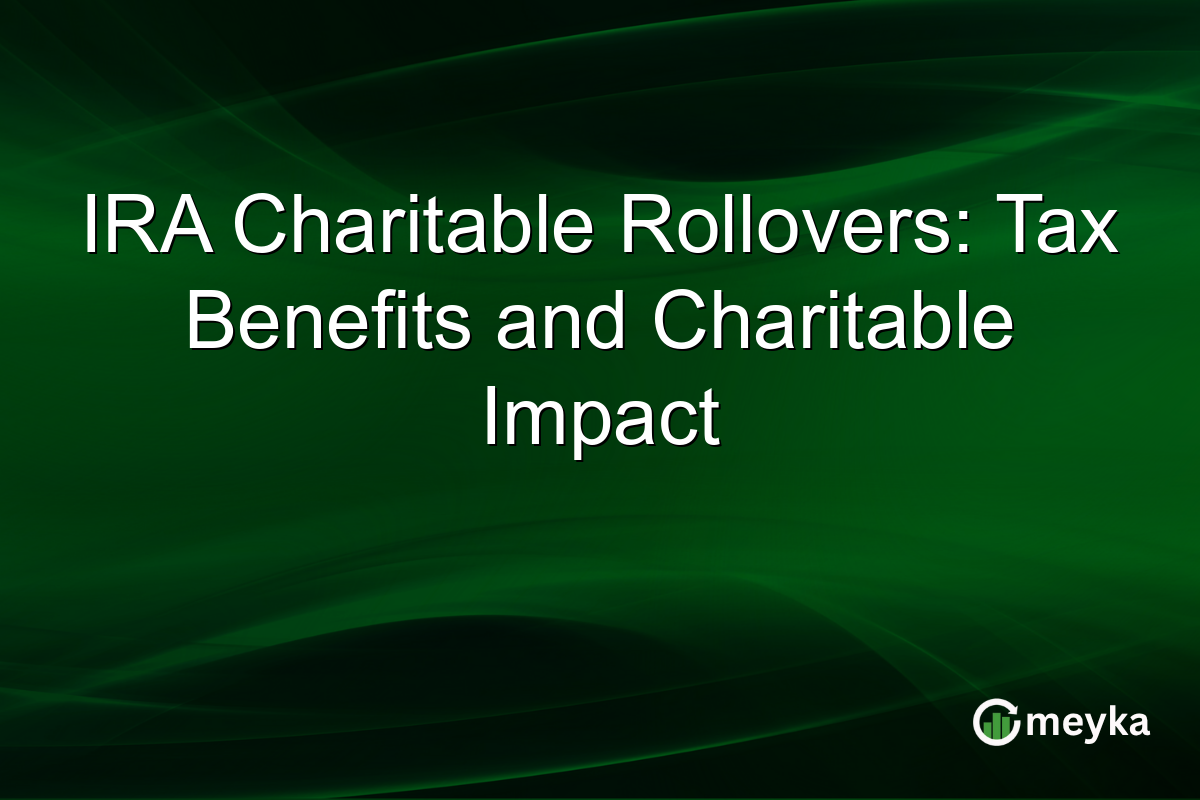IRA Charitable Rollovers: Tax Benefits and Charitable Impact
As the year-end approaches, many individuals aged 70½ and older are exploring smarter ways to manage their retirement savings. A growing trend is the IRA charitable rollover, also known as a Qualified Charitable Distribution (QCD). This strategy not only helps meet Required Minimum Distributions (RMDs) but also offers tax benefits and a chance to contribute to worthy causes. With increasing awareness, more people are realizing its dual benefits—financial efficiency and philanthropy.
Understanding IRA Charitable Rollovers
An IRA charitable rollover allows retirement account holders to contribute directly from their IRA to a qualified charity. This counts toward their required minimum distributions without increasing taxable income. Especially for those who don’t need the RMDs for personal use, it’s a savvy way to support nonprofits while reducing tax liability.
The limit for QCDs is $100,000 per year, per person. This means couples can funnel a substantial $200,000 annually to charities of their choice. These distributions cannot be claimed as tax-deductible, yet they provide a tax-free way to fulfill RMDs, leading to significant savings. Explore more on IRA strategies.
For retirees concerned about federal income tax, this strategy directly reduces adjusted gross income—helping avoid higher tax brackets and minimizing Medicare premiums.
Maximizing Tax Benefits
The tax benefits of IRA charitable rollovers are profound. By directly transferring funds to charities, individuals avoid recognizing the income. This is particularly appealing as it prevents crossing into higher tax brackets, which can occur with regular RMDs.
Moreover, this strategy can help senior taxpayers who do not itemize deductions. The QCD allows them to realize a tax advantage similar to those who itemize, giving them a method to align their charitable intentions with financial planning. This strategic alignment is key in maximizing one’s financial efficiency through careful planning.
Economically, avoiding extra income can also reduce tax effects on Social Security and Medicare premiums, further extending savings.
Charitable Impact and Community Support
The charitable impact of leveraging QCDs is significant. Nonprofits rely on such contributions not just for funds but also to galvanize support in communities. The reliable income from QCDs aids long-term planning and sustains operational stability for many charities.
By channeling funds directly from IRAs, donors can make large contributions that substantially impact their chosen causes. This social influence strengthens community ties, promotes goodwill, and enhances the charitable landscape. Organizations can better fulfill their missions thanks to such dedicated investments from older adults aiming to leave a meaningful footprint.
Here’s a recent discussion on X about how QCDs are shaping charitable practices.
Structuring a QCD Strategy
To implement a successful QCD strategy, consultation with financial advisors is crucial. Advisors help ensure that distributions are made correctly to qualify as QCDs and confirm that the receiving charities are eligible.
Proper documentation is essential. Confirmation receipts from charities and coordination with IRA custodians guarantee the process meets IRS requirements. For those with inherited IRAs, complexities around ownership timing might require special attention.
For retirees with goals extending beyond financial planning—such as philanthropy—structuring a QCD strategy facilitates both world-changing donations and effective wealth management.
Final Thoughts
IRA charitable rollovers offer a compelling blend of tax efficiency and philanthropic impact. For retirees seeking ways to fulfill required minimum distributions without incurring extra tax burdens, QCDs stand as a beneficial option. By bridging financial wisdom with charitable support, individuals not only enhance their tax strategies but also contribute significantly to societal welfare.
This powerful approach aids charities in achieving their missions and allows donors to see tangible outcomes from their contributions. Leveraging tools like Meyka for real-time insights can further optimize such financial decisions, ensuring both immediate tax benefits and long-term charitable success.
As more retirees consider this path, the dual advantages of QCDs—financial and philanthropic—become undeniable.
FAQs
An IRA charitable rollover, or Qualified Charitable Distribution (QCD), allows individuals aged 70½ and older to donate directly from their IRAs to a qualified charity. This fulfills required minimum distributions without increasing taxable income.
A QCD is excluded from taxable income, helping reduce adjusted gross income and potentially lowering tax rates, social security taxes, and Medicare premiums. It benefits those who do not itemize deductions by simulating itemized benefits.
The maximum transfer allowed for a QCD is $100,000 per person annually. Couples can transfer up to $200,000, providing significant opportunities for charitable giving and tax savings.
Yes, QCDs count towards fulfilling required minimum distributions (RMDs), helping individuals avoid penalties while maintaining control over their taxable income.
Disclaimer:
The content shared by Meyka AI PTY LTD is solely for research and informational purposes. Meyka is not a financial advisory service, and the information provided should not be considered investment or trading advice.






